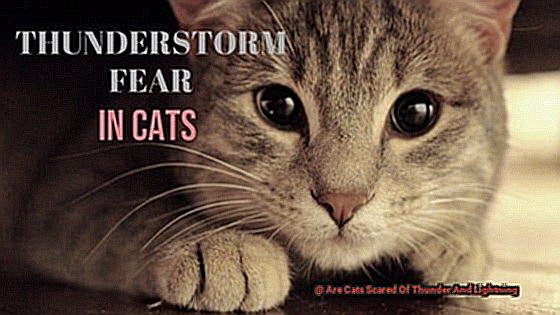Thunder and lightning, a dynamic duo that can send shivers down our spines.
But what about our feline friends? Do they cower in fear at the sound of thunder and the flash of lightning?
As cat owners, we often see our furry companions as fearless beings, but the reality is, they too have their own fears and anxieties. And when it comes to these natural phenomena, many cats are no exception.
Get ready to discover a new side of your beloved furball as we unravel the mystery behind their fear.
Are Cats Scared Of Thunder And Lightning?
Contents
Thunder and lightning, two natural phenomena that can strike fear into the hearts of even the bravest humans. But have you ever wondered if your furry feline friend shares the same fear? It’s a common question among cat owners, especially during stormy weather. So, let’s uncover the truth and find out if cats really do fear thunder and lightning.
First things first, it’s important to understand that cats are known for their unpredictable behavior and reactions to various stimuli. This can include loud noises, sudden movements, and even changes in their environment. So it’s no surprise that thunder and lightning, with their loud crashes and bright flashes, can cause some cats to become anxious and fearful.

But why is this the case? Well, it all boils down to their sensitive senses. Cats have a much more heightened sense of hearing than humans, allowing them to pick up on sounds that we may not even notice. This means that loud noises like thunder can be even more overwhelming for them. Additionally, cats also have sharp vision, meaning they can see even the smallest flashes of light from lightning.
But it’s not just their senses that play a role in their fear of thunder and lightning. Experts believe that this fear may stem from their wild ancestors’ instinctual survival mechanisms. In the wild, sudden loud noises could signal potential danger, causing cats to become fearful and seek shelter. This instinct may still be present in our domesticated feline friends, causing them to feel anxious and scared during storms.
So how can you tell if your cat is scared of thunder and lightning? Well, each cat may react differently. Some may show obvious signs of fear such as hiding, shaking or trembling, excessive grooming, or vocalizing (meowing or hissing). Others may act nonchalant or even curious. This can depend on factors such as past experiences with storms and the cat’s overall personality.
If your cat does exhibit signs of fear during storms, there are ways that you can help them feel more at ease. The first step is to create a safe and secure environment for them.
This can include providing a cozy hiding spot, such as a covered crate or a spot under the bed, where they can feel protected. You can also try playing calming music or white noise in the background to drown out the loud noises of thunder and lightning.
The Science Behind a Cat’s Fear Response
Cats Have Super Senses
- Their highly developed inner ear structures allow them to hear sounds at a much higher frequency and volume than humans.
- They can hear up to five times more than humans, making them very sensitive to loud noises like thunder.
Thunder and Lightning: A Cat’s Worst Nightmare
- The sound of thunder can reach up to 120 decibels, equivalent to standing next to a jet engine taking off.
- This sudden noise can startle even the calmest of cats, triggering their fear response.
Smell Plays a Part
- Cats have a heightened sense of smell and use it to navigate and perceive their environment.
- Thunderstorms produce strong smells due to changes in air pressure and the release of ozone, which can cause anxiety and fear in cats.
Evolutionary History
- Animal behaviorist Dr. Nicholas Dodman explains that the fear response in cats can be traced back to their evolutionary history.
- In the wild, loud noises could signal danger or the presence of a predator, causing cats to instinctively react with fear.
Sensitive Nervous System
- Cats have a sensitive nervous system that makes them more susceptible to stimuli such as loud noises.
- When exposed to a sudden noise like thunder, it triggers their flight or fight response, causing them to become anxious and fearful.
Certain Breeds are More Prone
- Studies have shown that certain breeds of cats may be more prone to developing a fear response towards thunder and lightning.
- Siamese cats have been found to be particularly sensitive to loud noises and may exhibit more intense fear reactions compared to other breeds.
Age and Previous Experiences
- Older cats may develop a fear of loud noises as they become more sensitive to changes in their environment.
- If a cat has had a previous traumatic experience during a thunderstorm, they may associate the noise with that negative event and react with fear.
Even Calm Weather Can Cause Anxiety
- Thunder and lightning can have an impact on a cat’s behavior even when there is no storm present.
- Some cats may display anxious behaviors such as hiding, pacing, or excessive grooming when they sense a change in the weather that could potentially lead to a thunderstorm.
Factors That Can Contribute to a Cat’s Fear of Thunder and Lightning
- Heightened senses: Cats possess incredibly sharp senses, especially when it comes to hearing. They can pick up on subtle changes in the environment, making them more sensitive to loud noises like thunder. This heightened sense of hearing also means that cats may perceive the sounds of thunder as much louder and more threatening than we do.
- Unpredictability: Unlike humans who can anticipate when a storm is coming, cats may not understand the cause of thunder and lightning. This unpredictability can make them feel vulnerable and anxious, leading to fear and hiding behavior.
- Past experiences: Like humans, cats can develop fears based on past experiences. If your cat has had a traumatic experience during a storm, such as being stuck outside during a particularly intense thunderstorm, they may develop a fear response to these events.
- Breed and personality: Some cat breeds, such as Siamese and Oriental cats, are known to be more sensitive and easily scared by loud noises. Additionally, a cat’s individual personality can play a role in their reaction to thunder and lightning. A skittish cat may be more prone to fear in general, while a confident cat may be less affected by loud noises.
- Changes in environment: Changes in a cat’s environment can also contribute to their fear of thunder and lightning. If they have recently moved or there have been changes in their living space, they may feel less secure during a storm.
- Socialization and exposure: A cat’s level of socialization and exposure to different stimuli can also impact their fear of storms. Cats who have had limited interaction with loud noises or unfamiliar situations may be more likely to experience fear during a storm.
So, what can you do to help your cat during a thunderstorm? First and foremost, it’s important to provide a safe and secure space for your cat to retreat to. This can be a cozy hiding spot or a familiar room where they feel comfortable.
Additionally, you can try playing soothing music or using calming pheromone sprays to help ease their anxiety.
Identifying Signs of Fear in Cats During Storms
First off, it’s important to know the signs of fear in cats during storms. One common behavior is hiding. Cats may seek shelter in enclosed spaces like under the bed or in a closet to feel safe from the loud noises and bright lights associated with thunder and lightning. Another sign is excessive grooming. Cats may groom themselves more than usual as a way to cope with stress and anxiety. Keep an eye out for increased shedding or hairballs.

Changes in behavior can also be a red flag for fear in cats during storms. Some cats may become more vocal, meowing or yowling more often. Others may become clingy or aggressive towards their owners due to their heightened state of anxiety. Physical symptoms such as dilated pupils, rapid breathing, and trembling are also common indicators of fear in cats during storms.
So, what can you do to help your cat during a storm? Providing a safe space for them to retreat to is crucial. This could be a cozy bed or hiding spot, preferably away from windows and doors where they can feel the wind and hear the thunder more clearly. You can also try using calming techniques such as playing soothing music or using pheromone sprays.
It’s important to pay attention to these signs of fear in cats during storms because prolonged exposure to stressful situations can have negative effects on their overall well-being. Understanding your cat’s behavior during storms can help you take necessary steps to keep them calm and safe.
Managing Your Cat’s Fear of Thunder and Lightning
Understanding and managing your cat’s fear of thunder and lightning can be a daunting task. As a cat owner, it is important to recognize that this fear is not uncommon among our feline friends.
With their heightened senses and natural instincts, it is no surprise that loud noises, bright flashes of light, and changes in atmospheric pressure can trigger fear in cats. However, with the right knowledge and techniques, you can help your cat cope with their fear and keep them safe during storms.
Creating a safe and comfortable environment for your cat is the first step in managing their fear. This can include providing a designated hiding spot, such as a covered crate or a quiet room with their favorite toys and blankets.
Closing windows and curtains can also help block out the sound and light from the storm. Playing calming music or white noise can also help soothe your cat’s nerves.
Another helpful tool in managing your cat’s fear is the use of pheromone sprays or diffusers. These products release synthetic versions of calming hormones that can help ease your cat’s anxiety during a storm. Simply spray the product in the designated safe space or plug in the diffuser in the room where your cat spends most of their time.
Distraction techniques can also be effective in redirecting your cat’s attention away from the storm. Interactive toys or treats can provide a fun and positive distraction for your cat. You can also try engaging them in playtime or grooming to help alleviate their fear.
It is important to remain calm yourself when your cat is scared. Cats are sensitive creatures and can pick up on their owner’s emotions. Avoid scolding or punishing your cat for being scared, as this will only increase their fear and anxiety. Instead, provide reassurance and comfort to let them know that they are safe.
If your cat’s fear of thunder and lightning is severe or causing distress, it may be best to consult with a veterinarian. They can provide recommendations for anti-anxiety medication or behavior modification techniques to help your cat cope with their fear. Remember to always be patient and understanding with your cat, as every cat will have a different reaction to storms.
Tips for Creating a Safe Space for Your Cat During Storms
These natural phenomena can be frightening for cats, just like they can be for humans. But don’t worry, with the right tips and techniques, you can help your cat feel more relaxed and comfortable during storms.
The first step is to identify a safe space for your cat to retreat to during a storm. This could be a spare bedroom, bathroom, or even a closet. Make sure the space is equipped with all the necessary items your cat may need, such as a litter box, food and water bowls, and a cozy bed or hiding spot. It’s also essential to make this space familiar to your cat by including their favorite toys or blankets.
To further create a calming environment, consider playing soothing music or using pheromone diffusers in the safe space. These can help relax your cat and reduce their stress levels. Keeping the space dimly lit or using a nightlight can also help soothe their anxiety.
During storms, it’s important to keep windows and curtains closed to block out the noise and flashes of lightning that may trigger your cat’s fear. You can also use white noise machines or fans to help drown out the sound of thunder.
If possible, stay with your cat in their safe space during storms. Your presence can provide them with reassurance and comfort. It’s also important to note that if you have multiple cats, each one should have their own safe space to avoid any potential conflicts.
Creating a safe space for your cat during storms can also involve practicing beforehand. Take your cat to their safe space during calm weather so they become accustomed to it and associate it with feelings of safety.
It’s important to remember that not all cats will react the same way to thunder and lightning. Some may show obvious signs of fear, while others may seem unfazed. It’s important to be aware of your cat’s behavior and provide them with the necessary support and comfort during storms.
Seeking Professional Help: Desensitization Techniques for Cats’ Fear of Storms
If you have a cat that is terrified of storms, you know how distressing it can be to see your feline friend trembling and hiding during a thunderstorm. While creating a safe space and providing comfort can help, some cats may require more intensive methods to overcome their fear. This is where seeking professional help for desensitization techniques becomes crucial.
So why is it important to seek expert help? Let’s take a look at the benefits of working with a professional behaviorist or trainer for your cat’s storm phobia:
Personalized Plan
Desensitization involves gradually exposing your cat to their trigger while providing positive reinforcement. However, every cat is unique, and what works for one may not work for another. A professional will assess your cat’s individual needs and create a personalized desensitization plan that takes into account their triggers, behavior, and personality.
Expertise and Patience
Desensitization requires expertise and patience. A professional behaviorist or trainer will have the necessary knowledge and experience to guide you through the process effectively. They can also help you understand your cat’s body language and behavior, making it easier for you to monitor their progress.
Long-Term Solution
While it may take time, desensitization can be a long-term solution for your cat’s fear of storms. By gradually exposing them to their trigger while providing positive reinforcement, the goal is to change their response from fear to a positive or neutral one. This can significantly reduce their fear response over time.
Combining Techniques
A professional can also combine desensitization with other techniques such as counterconditioning and environmental management for better results. Counterconditioning involves replacing the fear response with a positive one by pairing the trigger with something your cat loves, such as treats or playtime. Environmental management includes creating a safe and comfortable space for your cat during storms, such as a soundproof room with familiar items and calming pheromones.
Support and Guidance
Seeking professional help also provides you with support and guidance on how to continue these techniques at home. Your behaviorist or trainer can help you understand your cat’s progress and make any necessary adjustments to the desensitization plan. They can also offer advice on how to best implement counterconditioning and environmental management techniques at home.
Conclusion
For the record, the loud crashes of thunder and bright flashes of lightning can definitely scare our cats. Even though cats seem brave, they are sensitive animals that can feel fear and worry just like people do. Understanding why our pets are scared and how to make them feel better during storms is very important for us as responsible pet parents.
Cats are very afraid of thunder and lightning because their senses are so sharp. Because they can hear and see very well, storms can make them more vulnerable to quick changes in their surroundings. Not only that, but their past as hunters has also made them very alert to possible threats.
If you think your cat might be scared during a storm, you should know how to tell. These actions, like hiding under furniture or cleaning itself a lot, can be signs that your pet friend is scared and nervous. Making a safe place for them and using calming methods, like playing soothing music or scent sprays, can help them feel less scared.
However, for some cats, it may be necessary to get help from a behaviorist or teacher. We can gradually make our cats less scared of thunderstorms with individual plans and expert help. Some methods that can help our animal friends get over their fears are slow contact, counterconditioning, and managing their surroundings.
Most of all, we need to be gentle and understanding when our cats are scared. They can get the help they need during scary times like tornadoes if we love and care for them.






